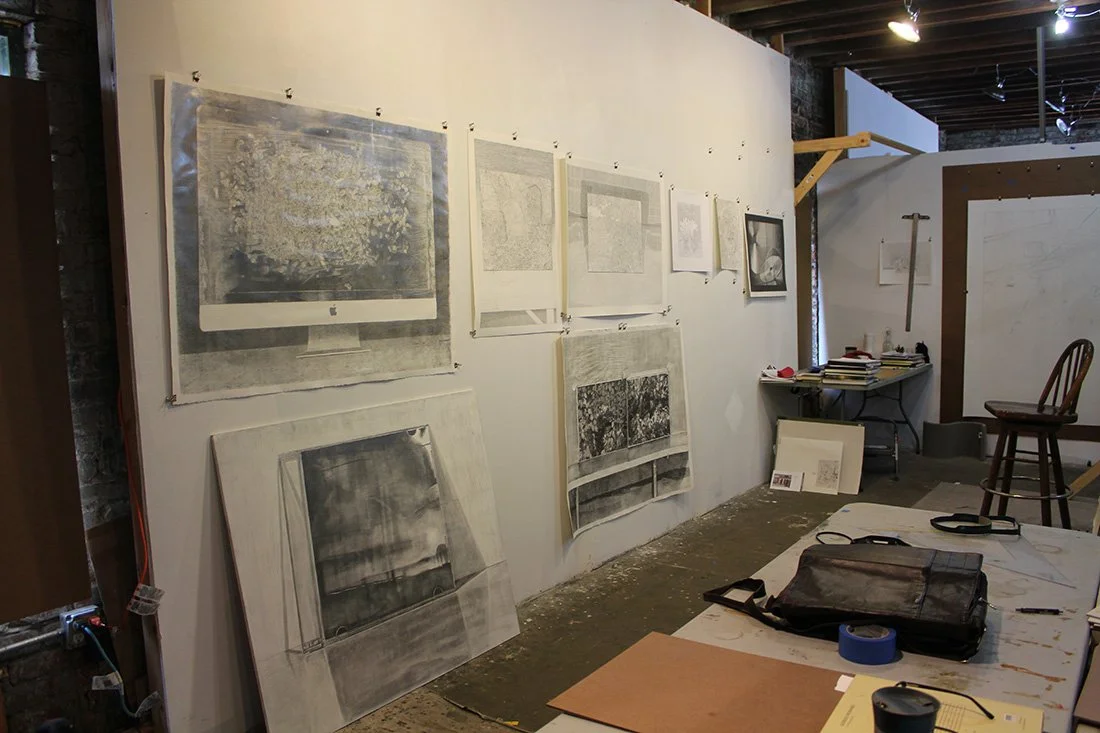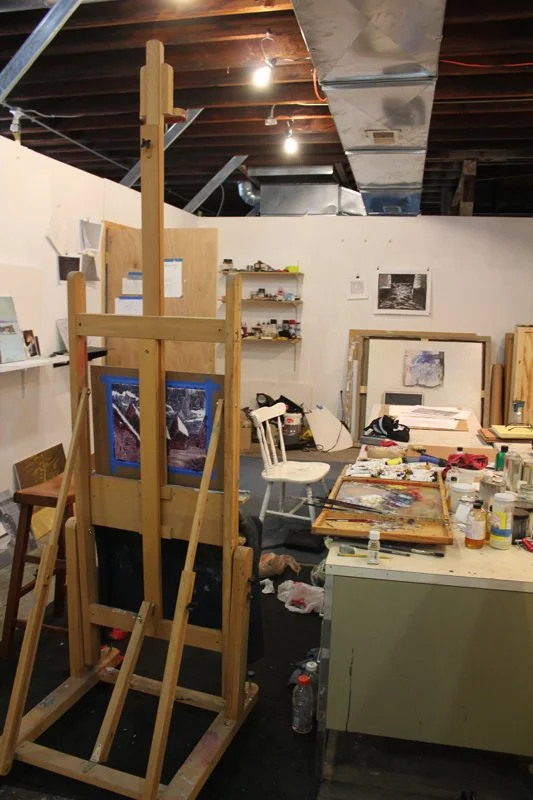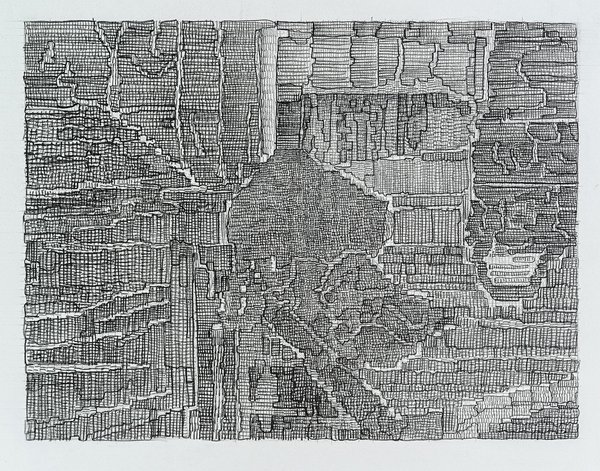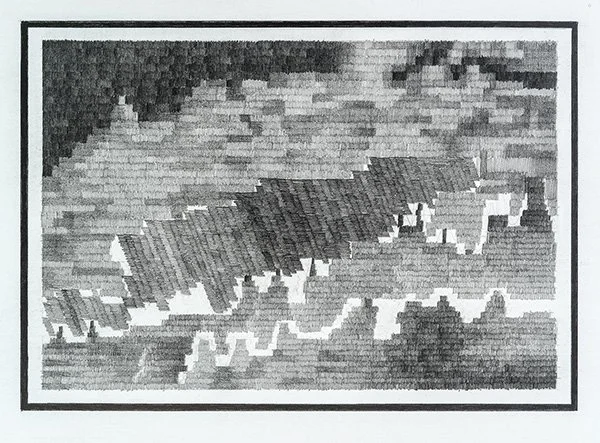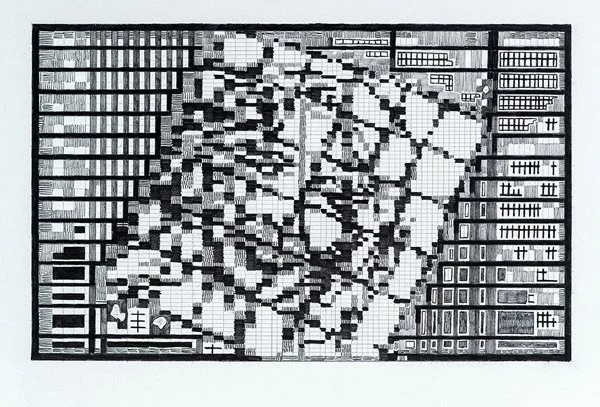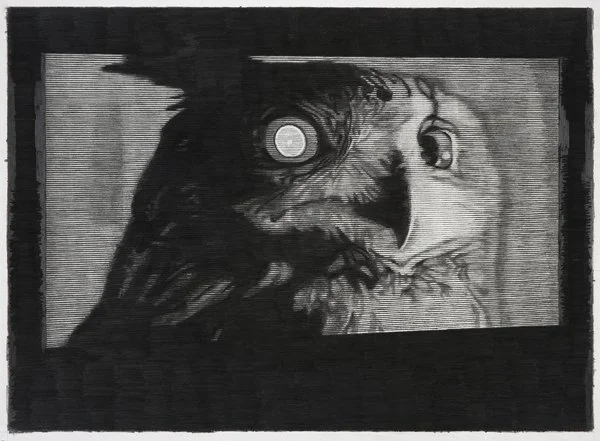Revisiting Past Through Drawing: an Interview with Jonah Criswell
Earlier this summer I visited Jonah Criswell’s studio in downtown Kansas City before work
was shipped out for his upcoming exhibition, Fernweh, at ReTramp Gallery in Berlin. The
converted warehouse space had the walls lined with small shelves holding various scales of
paintings, still life setups, and drawings. These tiny piles were organized like groupings of
photos in a camera roll, some with a seemingly sequential narrative and others experiments
in capturing one’s visual fascination in that moment.
Criswell just returned from co-teaching a summer workshop in New York City to students at
the Kansas City Art Institute, the institution where he teaches full time in the Painting
Department as Assistant Professor. The workshop revolved around a larger idea that
seemed to be pulled right from the conceptual organization if his studio practice. Asking that
students see their world in the same way they do the museum. Finding “moments in life to
cherish and describe through picture making.”
Jonah Criswell was born in Springfield MO but raised in Warner Robins, Georgia and
Pensacola, Florida. He graduated with a BFA from KCAI in 2005 and an MFA from
Pennsylvania State University in 2008, he has been teaching in KCAI’s Painting department
since 2011. In 2008 he was awarded a Charlotte Street Urban Culture Project Residency and
in 2014 he attended TaktProjekt, a residency in Berlin.
Melanie Mitchell: What are the larger ideas that your work is exploring?
Jonah Criswell: Nostalgia, longing, and there’s a concern with parts of my own life, I am interested
in the things that I’ve made in the past as objects to think about. Making a little painting, or finding
things like a mix cd, or these photographs I took while in Vancouver; using those as a symbol
for an unnamed emotional condition or desire. The drawing with the leaves is about me
thinking about where I want to live and whether or not I just long to live in that place, or would
I actually like living there. The cd playlist is more of wishing a person were there as opposed
to the CD but yet the CD is all I have. Longing, not necessarily regret but a sense of having
missed something is definitely something I think about a lot in the work.
“The Window” (image by EG Schempf, courtesy of the artist)
MM: What about the different mediums you’re using? How do you work between these
ideas in both painting and drawing?
JC: I don’t think the paintings are anywhere near where the drawings are. That’s why most of the
time I show drawings. Amanda Lechner, who’s a painter I really admire visited my studio in
October. She said “everyone’s drawings are always going to lead the way, it’s an older
skillset allowing for it to be a more rapid and intimate thing” I think that for the drawings I am
using a lot of straightforward materials but I like the fact that a drawing is never quite as real
as a painting. A painting has a greater capacity for illusion making, while drawings stand
outside the presence of reality because it is a tonal thing. I like that with the conceptual and
emotive forces that are at work in my studio. They implicitly are considering the ideas of
longing, the inavailabilty of something, and also a kind of historical presence. A thing that is
temporally located outside of the present but not quite in the past
“Make A Call” (image by EG Schempf, courtesy of the artist)
MM: What have you been listening to or reading while making this work?
JC: I listen to a whole lot of narrative podcasts, lots of science fiction. I can’t wait for them to
come out every week, so in the meantime I will go and download older podcasts from
EscapePpod which has years worth of stuff. I heard the Screwfly Solution by Alice B.
Sheldon recently and it was just a heartbreaking story, very Margret Atwood-ish. The woman
who wrote it worked for the CIA and was this fantastically complex and fascinating person
who then wrote this story. I listen to a lot of horror, sci-fi and weird fiction online.
For the work, I had been reading a bit about nostalgia but that wasn’t very helpful. I read an
article called Tourism and The Semiotics of Nostalgia by John Frow and that was really
interesting because he kind of talked about modernity and the simulacrum and the way in
which the binary of the genuine and the artificial is an insufficient binary paradigm to explain
what actually being in the world is. That was really helpful because it gives you a little bit of
latitude to think; Ok, so nostalgia isn’t just a kind of lame force that happens to you when
you’re in your mid thirties but it’s a part of living in a world that is constantly evolving.
As you get older you become more and more orphaned to the world. The world changes
and all the familiar things disappear and are replaced by things that are more helpful, more
scary, and also more interesting. I read Alastair Reynolds Slow Bullets which is sci-fi which is
great in the summertime after teaching all year reading theory, and talking about it all the
time. Fiction is really exciting because it’s easier to read and think about in studio because it
doesn’t turn your brain on the same way that theory does and so it doesn’t gobble up your
mental faculties.
When the studio work starts getting really tedious, i’ll take 10 minutes and read a few pages
and that reboots my whole mind. Which is really helpful. I also listen to a lot of history
podcasts and a lot of Skinny Puppy, a fantastic industrial band from the early 80s and lots of
other intense industrial music.
MM: What about the change in the work’s scale, it is moving larger and then smaller?
JC: The smaller drawings were an exercise in creativity. When I work on something really time
consuming I get fatigued really quickly or get hungry for something novel so the smaller
drawings were me watching the X-Files a whole bunch, taking screen shots from every
episode and then trying to have a conversation with the picture I liked so much. Far less a
description of the image that I saw and instead a superimposition of some other kind of logic.
These were kind of like fun holidays from the larger, more time consuming and craft
conscious pieces. There are almost thirty of these but I only show about seven of them
With the larger drawings, I didn’t want anything to be too much bigger than fifty inches, then I
found that I really love drawing on bristol paper because it takes marks superbly and it’s
pretty mutable. So the drawings of the paintings, I want them to be about three to four times
the size of the originals. That way the detail is still recognizable but at the same time it is not
so compressed that it feels impenetrably dense. The smaller these things get, the smaller
marks you have to make and then for me I wanted there to be more breathing room.
For the more tonally realized drawings on the oil grounded paper again I kinda wanted them
to reference the everyday but re-scale the eye of the viewer to make them and the reference
of their body much smaller so they can be invited to something thats a little bit overwhelming
or a little bit larger than life. Scale for me is in relationship to the rendering of the image and
the image has to scale the eye up or down a little bit. In the smaller paintings that I make just
out of a kind of habit, I like the intimacy that those bring and the fact that you can be
incredibly confident in some of those and you don’t have to second guess yourself. So much
of my work is about craft on command so its nice to take a holiday from that periodically.
MM: So in these you’re making reference that are far less direct to pop culture while in the
small drawings, the images are hard to recognize?
JC: The titles were hard for that. I wanted to title them “season_1_episode_3” or how you
download it off the internet “x-files_s01e03.mpv-hackers” Titles are kind of tricky because I
have a lot of saccharin heavy handed impulses so it was nice to kind of push the cultural
reference a little bit to the side. That gives another narrative so that when I tell people “These
come from X-files” that becomes a point for them to see how an artist sees something
nowadays is about a conversation with a subject matter or an influence, history etc and not
just a re-translation of it.
“Over The Hills” (image by EG Schempf, courtesy of the artist)
This is from a scene where there is just fog rolling in while Mulder and Scully are lost in the
woods and there are these bugs just trying to kill them. The fog rolling in was such a
romantic image. I wanted to capture just the things that I thought were beautiful and then
discard everything else that’s not relevant.
In a lot of ways that’s how the other drawings were, trying to essentialize an inspiration and
then just highlight things that inspired me. Sometimes it can be just the texture of the paint
on a surface.
MM: Yet these smaller drawings are really pixelated so did you physically distort them?
JC: Yes, there’s this thing called an Ames lettering guide and it’s awesome. I used to draw all of
my grids by hand which was time consuming, frustrating and really tedious. Ames lettering
guides used to be used by people who made isometric and orthographic drawings. It allows
you to draw a grid really fast because it has an adjustable dial that lets you change from
metric to standard.
I would do a loose sketch of the picture and then hide that away by putting different kinds of
grids at different widths down on top of it. Then I would just think, oh how do I want to
massage the essential qualities of the image away from its source into something I thought
was more provocative, more strange, or interesting. When you see something you’re really
interested in for the first time there’s always a sense of rupture. There is always a sense that
you’re not looking at something familiar and that’s why it is special. I wanted to double fold
that special thing that I saw and make it new again.
“His Sister” (image by EG Schempf, courtesy of the artist)
You can see it really clearly in this one the grid that underpins the whole thing. You can also
see the changes in the width. I have a few rules where I was embracing the consistent error.
Its interesting to see how you can communicate with that. This image was where Mulder
looks down off these stairs and he sees a kid who is trying to make a picture through this
binary language of his long lost sister. I like that the grid allows you to abstract something
which gives you a little bit of freedom. Craft itself is like a cave and you can go really far into
it but there’s a nice moment where the wall of the cave is more shallow. I dont need to go
into drawing every eyelash on a person’s face, I have a limit. That limit allowed me to think
about design — drawing a line and then responding to a previous line. These were thinking
about different kinds of playful structures and how you can respond to each one of those.
MM: I thought those were glitched in a computer?
JC: No, however I did that for awhile I have maybe 3gb of data moshed images, I would take
trailers from movies I was really excited about seeing and then datamosh the trailer and do
screen shots and pick the one I really liked, then doing a really uptight drawing of that. It
seemed a little too gimmicky. I still love looking at those pictures because when I was doing
the TV drawings I had to learn a little bit about CRT televisions, the way they have a certain
refresh rate and the way the pictures are structured and the fact that they have only 3 green
dots per 8 dot space. I liked seeing the thumbprint/failure of technology on this newer image.
You would see the subtle moire pattern which was really beautiful. Sometimes the
thumbprints on the glass are really beautiful even though they might obstruct the purity of the
image.
“I Like Your Owl” (image by EG Schempf, courtesy of the artist)
MM: There was a thing you mentioned earlier about “appropriation as karaoke” can you
explain that metaphor a little and do you feel that it relates to your work in any way?
JC: Yeah Angela Dufresne gave a lecture at the college (KCAI) and she said her work was a lot
like karaoke. I thought that was a really exciting premise which is basically being really
honest about what we do as artists. We’re in conversation with history and the present,
Dufresne said it was like singing a song from Tina Turner, and so she’s pushing that song
through her body and its changing. At same time she is using a format or a structure that has
a shared narrative. So with my drawings now, I am thinking a lot about a painting that takes
an hour to make, then spending 3 months drawing it. There is something about paying very
close attention to a really ephemeral organic moment of “oh I’m going to make a painting of a
cottage” but then when you meticulously look at every brushstroke that you made there is
something about looking at the performance of each mark and thinking about where in that
performance lies some kind of beauty, excellence, excitement, passion of those things. So
when I was going through and drawing the paintings, they are all earnest attempts to
understand why this thing is beautiful to me. The drawings of objects are much more staged,
and that’s more like trying to write a song or changing words around in a song to make it do
something different. Theres the one part where you’re trying to make something that explains
a certain emotional condition and your using objects and then pictures to do that. Then the
drawings of paintings are more like doing something amazing once and then figuring out
again, how did you do that? The thing that I’ve learned making art for so long is that
controlling the instrument of your own psychology when you’re making something is really
important. Thats been the subject of my thoughts for the past year. Dufresne’s lecture made
me realize that she has a lot of control over her instrument of performing a painting.
MM: You just taught a class in New York over the summer. What the focus there?
JC: The second week in June I taught a class on “what is the museum” Being next to a museum
is nice because you can go over there and see something that is a controlled presentation of
a really beautiful thing. Museums hold information and cultural anomalies of relevance. They
are also places you go to see something extraordinary. The premise of my part of the class
was “where are the boundaries of the museum?” In a lecture at KCAI, Dawn Clements
commented on how she found some rubbish on the ground walking to some place and then
made drawings of it. She was inspired by a little wrapper and in a lot of ways the museum for
her is anywhere that she needs it to be.
The thesis of the class is a question of can we pay attention to our lives as an
undecipherable and complex museum? When we go into a museum were going into a place
that – for all of its problematic qualities – if we take it at face value, we see that the museum
is a place. That there are not singular locations that we can be inspired by but when we
leave the museum we take the walls with it. Every place is the museum. Thats one of the
things that I love about contemporary culture is that people are shooting photographs of
things all the time. They’re collecting things that they found impressive or noteworthy. When
you look through and see the highlights, that’s like an artistic practice. Its subconscious in
one way, or one might say culturally ubiquitous but I think that one of the best things for
teaching people to appreciate being is making everyone photographers with their phone.
It may be a little bit lame if someone sits down and shoots a photograph of what they’re
going to eat and yes you can question, “are they just shooting it so they can brag on
facebook” but at the same time these people are really paying attention to something that we
might not share or something that we might overlook.The class was challenging student’s
thoughts regarding the museum experience, and then bringing that back to their lives. There
is something about looking at our lives, being able to appreciate that and find a way to
describe it through picture making and that’s what i wanted students to think about.
MM: How did the class go overall?
JC: It went well actually! The students in some cases were very autobiographical and in other
cases were definitely looking at their previous works and thinking about how they can
present different aspects of their experiences, instead of staying in their comfort zones. I only
had them for about a week but I think for an exercise such as that one, a week is good
enough to plant a seed. Personally, I was also interested in how I could see the city, New
York, as one continuous aesthetic experience, which is basically a cheeky way of saying I
spent way too much money on food and chocolate! I was really impressed with the students’
commitment to being in New York and making the most of it.
“The Cottage” (image by EG Schempf, courtesy of the artist)
MM: You have an exhibition coming up this fall in Berlin, what is the work in that exhibition
about?
JC: These drawings for me are an act of longing for a better self. Using personal artifacts as still
life subjects, I work to find and converse with my youth. Additionally, some of the works
reference television shows that I watch. The conversation between my visual language and
the “returned image” in all of these works describe the exchange between a strange world
and a fragility that I find exciting and humane. Its new work and it feels strange to have it not
in my studio. I miss it but I am thrilled to see it in an exhibition space, which often reveals a
lot that I couldn’t see about it in my studio.
“Greek Storm” (image by EG Schempf, courtesy of the artist)
Criswell’s upcoming exhibition Fernweh will be presenting new work at ReTramp
Gallery, Reuterstrasse 62, Berlin, Germany on October 2nd, 2015. For more
information on his work visit http://jonahcriswell.com/


